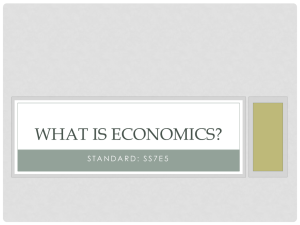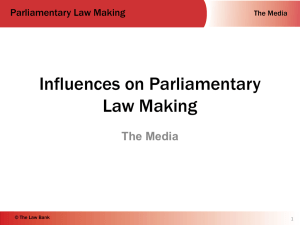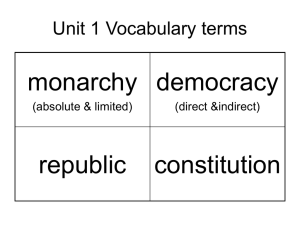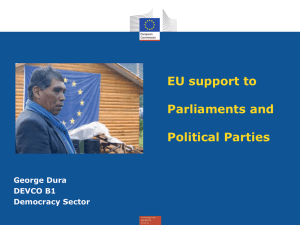Institutional Foundations of Military Coups d`Etat: Parliamentarism
advertisement
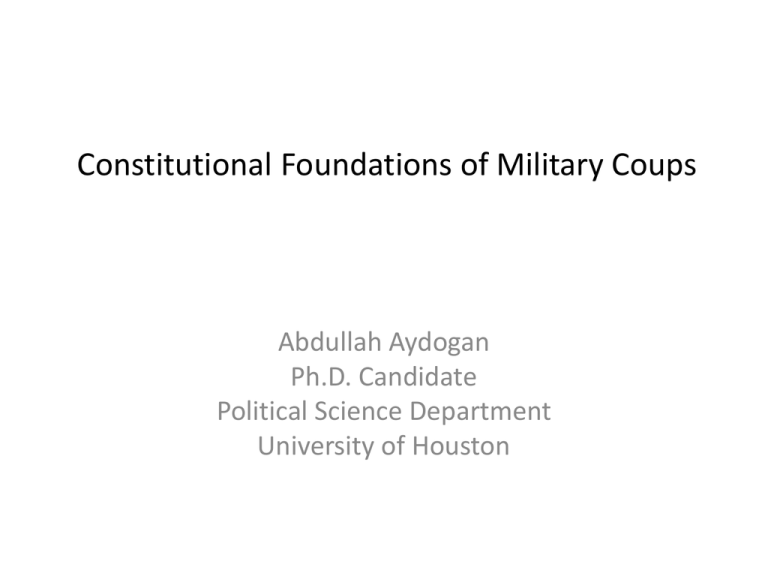
Constitutional Foundations of Military Coups Abdullah Aydogan Ph.D. Candidate Political Science Department University of Houston Puzzle • Military Coup Literature – Region Studies • Africa • Latin America – Cross Country Studies • Lack of constitutional design variable • Democratic Breakdown Literature (Perils-of-Presidentialism) – Neglect political influence of military in a world outside of established democracies – Mostly fail to distinguish between different types of breakdowns – Only focus on democratic countries • 1950-2006 (excluding fully authoritarian states like kingdoms): 91 military coup occurred, only about 20 of them were in democratic countries. Does Constitutional Design Matter? • Endogenous Explanation: – Mechanism in “Perils of Presidentialism” (Linz 1978); • • • Fixed term rule Winner takes all Dual legitimacy – Horowitz (1990), Mainwaring and Shugart (1997), Shugart and Carey (1992), Stephan and Skach (1993), Cheibub and Limongi (2002) and so on… • Exogenous Explanation: – Military Legacy (Cheibub, 2007) • Criticisms to Exogenous Explanation: (Sing 2012, Maeda 2012) • Different Theoretical Approach: – Discussing the inherent features of parliamentarism. • Mechanism proposed here; – Military Elites’ influence on political decision making, particularly during government formation processes in developing world – Inherent features of parliamentarism makes military elites even more influential. Theoretical Framework • Inherent features of parliamentary systems give alternative options to the military, which are less costly, so that they do not need to conduct a coup, but they get what they want. – Inherent features • possibility of coalition governments • early government terminations • vote of no confidence – Alternative option • threatening the political arena and creating an ideologically desirable government from the parliament. • Such a threatening possibility is not a best option for the military in presidential systems because – There is no vote of confidence rule, and impeachment procedure is highly costly. • Nevertheless, impeachment occurs and military uses this procedure as a new mechanism that replaces the military coups in Latin America. (Perez Linan 2007) – Resignation of a chief executive will require new elections or constitutionally mandated successor to be chief executive Civil-Military Conflict of Turkey in 1997 and Egypt in 2013 • Parliamentary Vs. Nonparliamentary • Several similarities – Culture and demography – Islamist movements and parties • National Outlook and Muslim Brotherhood • Welfare Party and Freedom and justice Party – – – – Success of Islamist movements and military’s reaction Economy and social classes Military prerogatives (economy and judiciary) Historical circumstances Civil-Military Conflict of Turkey in 1997 and Egypt in 2013 • Military’s response in Turkey: Threatening – Prime minister resigned – 37 legislators of a coalition party resigned and joined to another party – New coalition was formed and the military’s reaction settled down. • Military’s response in Egypt: Coup – The above strategy is less costly. – Why Egyptian military did not use it? EITM Framework • Theoretical and statistical concepts: – Decision-making – Discrete choice (to conduct a coup or not) • Theoretical and statistical analogues: – Game-theoretic bargaining model, Utility maximization – Probit and Survival Model (in both cases dep. var. is binary) • Unifying analogues – Military elites will decide to conduct a coup, or not to do so, depending on the opportunities the constitutional design provides, and other actors’ strategies. Actors and Their Possible Choices • Chief Executive – Acquiescence to the Military Ideology – Not Acquiescence to the Military Ideology • Military – Coup – Threaten the Politicians – Nothing • Chief Executive – Resign – Not Resign • Parliament – Dismiss the Chief Executive – Not Dismiss the Chief Executive Notations for the Bargaining Model A: x: The payoff chief executive receives when he pursues her own policies in office. The cost chief executive pays when he acquiesces. B: The payoff military elites receive when they pursue their own policies. P: ce : The payoff parliament aggregately receives in case there is no exogenous intervention The cost chief executive pays when faces military coup. cm: The cost of conducting military coup. cp: The cost parliament pays when faces military coup. te: The cost chief executive pays when faces threat and pressure for resignation by military. tm: The cost of threatening and pressuring to change the government composition. (t m < cm) tp: The cost parliament pays when faces threat and pressure from military for resignation of chief executive, but does not (need to) dismiss chief executive d e: The cost chief executive pays when dismissed by the parliament (d e > te) dm: The cost military pays when the parliament is forced to dismiss the chief executive dp: The cost parliament pays when dismisses chief executive due to military pressure (dp= lpn) lp: Parliament’s level of loyalty to democratically elected chief executive n: Number of legislators necessary to be persuaded to dismiss the chief executive Bargaining Between Military and Chief Executive Chief Executive Acquiescence Not Acquiescence Military A-x B P Threat Coup Nothing Chief Executive -ce B-cm P-cp Not Resign Resign Parliament -te B-tm P-tp Dismiss Chief Executive -de B-dm-tm P-dp Not Dismiss A-te -dm-tm P-tp A 0 P (lp n) > tp (Presidential Systems) Chief Executive Acquiescence Not Acquiescence Military A-x B P Threat Coup Nothing Chief Executive -ce B-cm P-cp Not Resign Resign Parliament -te B-tm P-tp Dismiss Chief Executive -de B-dm-tm P-dp Not Dismiss A-te -dm-tm P-tp A 0 P (lp n) < tp (Parliamentary Systems) Chief Executive Acquiescence Not Acquiescence Military A-x B P Threat Coup Nothing Chief Executive -ce B-cm P-cp Not Resign Resign Parliament -te B-tm P-tp Dismiss Chief Executive -de B-dm-tm P-dp Not Dismiss A-te -dm-tm P-tp A 0 P Hypotheses • H1: Parliamentary systems are less prone to military coups. • H2: Parliamentary systems allow more elite influence on politics in between elections. (will be tested in future) Data and Method • Years: 1960-2006 • Number of countries: 125 – (57 parliamentary, 68 presidential or semipresidential) • Unit of analysis: regime years • Method: – Probit – Survival Model (Cox Proportional Hazard Rate) Dependent Variable • Military coup: it takes value of 1 if a coup occurred at a country in a given year, 0 otherwise • Definition: “illegal and overt attempt by the military or other elites within the state apparatus to unseat the sitting executive that provides at least 7 days of ruling power to the perpetrators” (Powell and Thyne 2011) • Aim is resignation of chief executive • Incoming chief executive does not need to be a general Independent Variables • Parliamentarism: takes value of 1 if a system is parliamentary, 0 otherwise. Obtained from Gerring et al. (2009) • Log of GDP per capita (lagged for one year) • Change in the GDP • Change in military expenditure • Log of number of military personnel • Soldier quality (which is calculated through dividing military expenditure by the number of soldiers) • Military legacy • Authoritarian dummy Results Survival Estimate Graph .5 0 .25 percent survival .75 1 Kaplan-Meier survival estimate 0 10 20 30 analysis time 95% CI 40 Survivor function 50 Results Survival Estimate Graph by Constitutional Design .5 0 .25 percent survival .75 1 Kaplan-Meier survival estimates 0 10 20 30 analysis time 95% CI parliamentary = 0 40 95% CI parliamentary = 1 50 Results Survival Estimate Graph by Constitutional Design (Excluding Consolidated Democracies) .5 0 .25 percent survival .75 1 Kaplan-Meier survival estimates 0 10 20 30 analysis time 95% CI parliamentary = 0 40 95% CI parliamentary = 1 50 Multivariate Analyses VARIABLES Parliamentary Change in GDP Change in Mil. Exp. Soldier Quality Log Mil. Personnel Log GDPPC(lagged) Probit Probit Probit Duration Model Polity IV -5 to 9 Probit No SemiPres Polity IV 0 to 9 Polity IV 6 to 10 Polity IV 0 to 9 -0.16 (0.318) -2.93 (2.014) -0.36 (0.359) -0.17 (0.121) 0.06 (0.065) -0.44** (0.201) -0.44* (0.247) 0.24 (1.636) 0.11 (0.142) -0.35*** (0.109) 0.09 (0.073) -0.28 (0.213) -0.43** (0.209) -0.69 (1.042) 0.05 (0.077) -0.47*** (0.086) 0.09 (0.056) -0.06 (0.166) -0.74*** (0.269) -0.86 (1.786) 0.27* (0.162) -0.36*** (0.128) 0.12 (0.098) -0.19 (0.244) -0.62** (0.277) 2.78*** (0.993) -0.94*** (0.237) 3.15** (1.285) -0.88*** (0.206) 2.47** (0.975) -1.13*** (0.289) 2.79* (1.572) -0.88** (0.367) -1.09 (1.641) -0.05 (0.137) -0.35*** (0.115) 0.05 (0.075) -0.33 (0.239) -0.40* (0.229) -1.26*** (0.354) 1,779 1,148 1,448 893 Authoritarian Military Legacy Constant Observations Robust standard errors clustered by country in parentheses *** p<0.01, ** p<0.05, * p<0.1 2,788 Post-Estimation Graphs Figure 2B: Cox Proportional Hazards Regression (Smoothed Hazard Function) .006 .004 0 .5 .6 .002 .7 Survival .8 Smoothed Hazard Function .9 .008 1 .01 Figure 2A: Cox Proportional Hazards Regression (Survival) 0 10 20 Analysis Time (in years) 30 40 5 10 15 Analysis Time (in years) 20 25 The solid line represents presidential systems and dashed line represents parliamentary systems. Conclusion • This study aimed to make two contributions to the literature: – Theoretically • Proposed an alternative theory in regards to how military elites are influential in political decision making process and how this may change the probability of coups. • Challenges the superiority of parliamentary systems as demonstrated by Linz. (“Parliamentarism provides a more flexible and adaptable institutional context for the establishment and consolidation of democracy.” Linz 1990) – Empirically • Examines a data on military coups which has not been tested before. Future Research • Quantitative analysis introducing a variable for electoral rules. • Direct way to test the influence of elites on government formation (H2). • Collect data on military’s influence on the government formation and termination.


